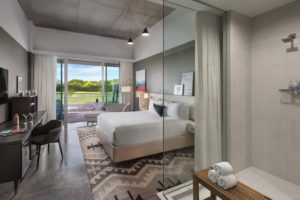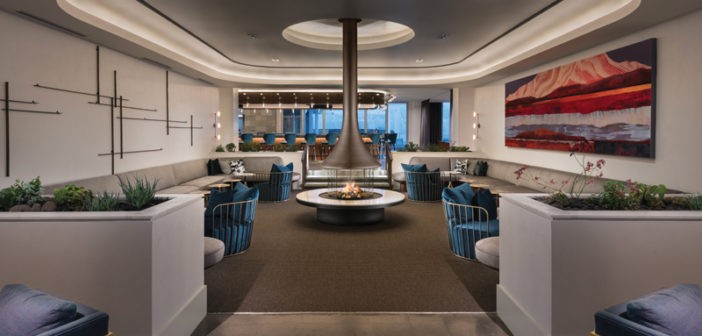With the grand opening Nov. 1 of Mountain Shadows in Paradise Valley, Arizona now has another phoenix.
Rising from the site where its like-named predecessor was built in 1959, the new-construction, 183-key destination property came out of the ground via co-owners Woodbine Development Corp. and operator Westroc Hospitality, which tasked design firm MarkZeff with recalling the original hotel within a modern-day format.
“We saw an opportunity to create something unique in a market where resorts are typically developed in the same form, fashion and scheme,” said Woodbine Managing Partner/Chief Investment Officer Dupree Scovell. “When The Arizona Biltmore came to be way back when, it was very different from what had been or has been seen since. In that same way, newly built Mountain Shadows is distinctive by virtue of its very modern architecture and design. It’s a resort that offers a fresh take on what has traditionally been done in Phoenix.”
The original Mountain Shadows was built in a crescent moon shape around an enormous pool and drew any number of celebrities of the day to the resort. Over time, the hotel lost its luster, the movie stars left and the property eventually fell into disrepair.
According to Scovell, the original structures were demolished before Woodbine and Westroc acquired the site and began a multi-year process of designing the resort’s next iteration.
“Our desire for timelessness was a driving force for keeping the new building’s architecture and design understated—building something that’s very contemporary with a tip of the hat to its mid-century predecessor,” he said.
“Additionally, we wanted Mountain Shadows to be a gathering place for locals and guests at the heart of Paradise Valley—just as the original resort was for many generations,” said Scott Lyon, Westroc’s founder, managing partner and CEO. “We also wanted to capitalize on the unique entitlements that existed. The newly built resort is the first three-story commercial building in the history of the town, so we wanted to make sure that wasn’t controversial. The resort also is part of the first resort community in the Phoenix market since the 1960s, and it has set the aesthetic for the adjacent condos and homes being built.”
The project took eight years and some $100 million to complete, with the owners and the design firm collaborating to bring the vision to fruition.
“Dupree and I made it a point to be on the same page before engaging a designer, and it was enjoyable to have a counterpart like Dupree who ‘gets it’ from an aesthetic standpoint and has the perspective of the generation below my own,” said Lyon. “We were both very involved with the architect on the site plan and layout as well as the selection of the interior designer. When we got the presentation from the various design groups, there wasn’t much to discuss. We had a consensus that the Zeff group understood what we were trying to accomplish.”
Stacie Meador, director of hospitality design for MarkZeff, toured a handful of local projects, finding most of the other properties had a traditional turn.
 “Our and the ownership’s vision was to create something completely different for the marketplace versus emulating or building on something that already existed. So, we pushed the boundaries and made Mountain Shadows a bit brighter, bolder and more modern, and graphic versus tonal and neutral. Allen + Philp [Partners] was the architect on the project, with principal architect Mark Philp serving as the visionary behind the architecture, site planning and material palette, which worked seamlessly with the interiors,” said Meador.
“Our and the ownership’s vision was to create something completely different for the marketplace versus emulating or building on something that already existed. So, we pushed the boundaries and made Mountain Shadows a bit brighter, bolder and more modern, and graphic versus tonal and neutral. Allen + Philp [Partners] was the architect on the project, with principal architect Mark Philp serving as the visionary behind the architecture, site planning and material palette, which worked seamlessly with the interiors,” said Meador.
She said the firm embraced elements in mid-century design, creating open floorplans in the guestrooms and public areas and, where possible, opened up the interior spaces to the outdoors. “We wanted the guest to feel a connection to the exterior… The interior architectural elements of the new resort reflect the clean lines of that [mid-century] era. For the interior furnishings, we kept a minimal fabric palette with clean, modern lines on the furniture to create a timeless, sophisticated space.”
Some of that timelessness, said Meador, came from the desert landscape. “The terrain, the foliage, the horizon and dusty, muted sunsets—all were inspiration for the custom artwork, carpet, furniture and the room palette. In the public areas, we used varied succulents in planters and infused natural polished concrete on the floors and teak wood on the walls to provide a material contrast authentic to the location.”
Early on in the process, Scovell championed the term “approachable luxury.”
“Luxury doesn’t have the same connotation that it used to. Luxury used to evoke an aspirational ideal with tails and white gloves; today, that feels elitist and stuffy. The guestrooms are a perfect manifestation of what we mean by approachable luxury: concrete floors, luxury tile and finishes, window-framed mountain views. They’re sophisticated, refined and spacious, and yet comfortable,” said Scovell.
As a new-build, Mountain Shadows required a good deal of input from the design side. “Our efforts included all of the interior planning, interior design, interior finishes and furniture selections, along with some art-specific collaborations. We custom-designed the furniture for the guestrooms, avoiding large matching casegoods, and adding curated artwork and area rugs to achieve the feel of a small, loft apartment. The open layout maximized natural light in the room by locating the shower with glass on three sides in between the bedroom and bathroom,” said Meador.
“We collaborated with the architect and landscape architect, as well as the branding agency, to ensure the brand and interiors were cohesive,” she continued. “I had found 10 different vintage Arizona travel postcards on eBay, which we put in the model room, and then those were later developed with the branding company to be included in the room. I also found a bunch of old highway maps and tourist books of Scottsdale—those were really fun and campy—and we worked with the branding company to integrate these ideas as well.”
The landscape drove much of the inspiration. “On the materials side, we sourced what felt authentic to the desert location, including concrete floors, area rugs, lime-washed paint finishes, terracotta tiles, graphic concrete tiles and teak woods,” Meador said. “The antique brass finishes were a bit of a departure, but a nice twist that aligned with the luxurious aspect of the resort. We mostly kept the materials and color palette simple and understated, as we felt this would be more powerful.”
“The architecture is understated to focus on the mountains, views and sunsets. The exterior is more austere, but the interior offers a sense of warmth, comfort and welcome, and its design elements not only decorate the space but frame up the views,” said Lyon.
“When you enter, the overall design experience is purposefully restrained—we didn’t want to detract from the landscape and Camelback Mountain, but, instead, let it speak for itself,” said Meador. “The reception area was the reverse of interior design: We simply framed the view. Everything else set into the space was intended to be quiet—beautiful, but quiet.”
Lyon said the reaction from the community thus far has been overwhelmingly positive. “We had 1,200 people at our recent grand-opening event, and half of the attendees were local. The mayor, town council and the staff also are thrilled. We sought to exceed quality standards across the board, which makes it a win for them, us and our guests,” he said. HB


